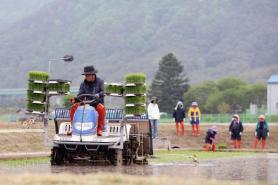
SEOUL, October 14 (AJP) - For generations, rice has been more than just food for Koreans — it has been the foundation of daily life and the symbol of a shared table.
But that symbol is fading. In the 1970s, the average Korean ate more than 130 kilograms of rice each year. By 2024, that number had fallen to just 55.8 kilograms.
As bread, noodles and ready-to-eat meals became more convenient, rice quietly lost its central place in the national diet. The decline is not only cultural but economic, shaking the foundations of Korea’s rice farmers and threatening the sustainability of the industry itself.
Yet rice may still have a future — not on the plate, but in the bottle.
Traditional Korean liquors such as makgeolli, yakju and distilled soju could offer a new path forward for rice. These drinks, deeply rooted in Korea’s fermentation culture, are enjoying a quiet renaissance as home drinking and artisanal products gain traction.
But nostalgia alone will not sustain the industry. To survive — and thrive — Korean traditional liquors must evolve into premium beverages with global appeal. That requires more than rediscovering old recipes. It means investing in unique ingredients, rigorous production standards, scientific quality control and, crucially, cultural storytelling that gives each bottle a sense of place.
Korea can take lessons from countries that have elevated their traditional liquors to international prestige. France protects its wines under the Appellation d’Origine Contrôlée (AOC) system, ensuring that every bottle reflects the terroir and craft of its origin.
The United Kingdom enforces strict regulations for Scotch whisky, guaranteeing authenticity and consistency. Japan has turned sake into a global product, quadrupling exports by refining its production standards and positioning it as both a cultural and luxury item.
The common thread among these successes is clear: science, structure and story. Each nation built institutional frameworks that link agricultural identity to product quality — a foundation Korea has yet to fully establish for its traditional liquors.
To chart its own path, Korea must start with its raw materials. Developing distinct rice varieties for brewing can lend character and flavor diversity, while the use of local agricultural products can ground liquors in regional identity.
Next comes scientific fermentation, using indigenous microorganisms to maintain quality, improve efficiency and cut production costs. A robust quality evaluation system — complete with flavor profiles and grading standards — could bring consistency and trust to both domestic and international markets.
Finally, Korea must craft a narrative. The story of regional rice, local yeast strains, and centuries-old breweries can transform a drink into a cultural experience. It’s this storytelling — linking rice paddies to pour — that can elevate a traditional beverage into a national brand.
If Korea succeeds, its traditional liquors could become more than regional curiosities. They could become an integrated part of K-culture, connecting food, agriculture, tourism and design in a single narrative — one that celebrates both the farmer’s labor and the brewer’s art.
Turning traditional liquor into a premium export is not just an economic opportunity. It’s a cultural act — a way to give rice a new life, to honor the country’s agricultural roots, and to project a modern Korean identity abroad.
From the dining table to the glass, rice can once again bring people together — not only across the Korean peninsula, but around the world.
* This article, published by Aju Business Daily, was translated by AI and edited by AJP.
Copyright ⓒ Aju Press All rights reserved.



